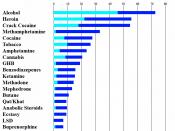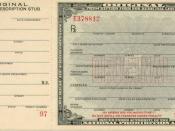A common problem faced in America today deals with substance abuse. It has been a long debate whether or not prohibition of drugs and alcohol are practical. An excellent example to related whether or not the idea works is the 1920s prohibition alcohol. Also, the 1980s Swiss experiment with the polar opposite of what happens when there is a legalization of drugs. With this the comparison of the relation of prohibition of substance and the legalization can the actual intent can be viewed. It is a matter of theory versus reality.
On January 16, 1920 the 18th Amendment was ratified. It stated "the manufacture, sale, or transportation of intoxicating liquors within, the importation thereof into, or the exportation thereof from the United States and all territory subject to the jurisdiction thereof for beverage purposes is hereby prohibited." It was with this new amendment the dawning of a new era was expected.
Those who ratified it expected "to reduce crime and corruption, solve social problems, reduce the tax burden created by prisons and poorhouses, and improve health and hygiene in America"(Thorton 1). The reasoning was with it not readily available, people would not go to lengths to obtain it. Also, if any illegal manufacturing would be to occur, the price would be too high for any to be interested. At the start of prohibition consumption did indeed fall but only in the beginning. In 1921 alcohol consumption was down around 67% (Clark 22), the lowest it had been in years. However, after 1921 the consumption of illegal alcohol began to skyrocket; to more than before the prohibition.
The 1920s is known for it's organized crime. It is primarily responsible because of the prohibition of alcohol. There became a surplus of gangsters, bootleggers and speakeasies. Speakeasies were places where you could buy...



Substance Abuse
This was a very well written essay, you use references and quotations to back up your arguments and it is a very interesting subject. Personally I think all substances, with the exception of (due to the extremity of the addiction) Heroin and Crack Cocaine, should be legal. I think substance abuse would rocket at first but then subside. One thing I thought you might have included, which you touched on when you spoke of the alcohol prohibition, was that if drugs were legalised then the government would be able to control what was in them. The drugs would then be of the purest quality and not be mixed with things like rat poison, thus regulating their safety.
7 out of 7 people found this comment useful.